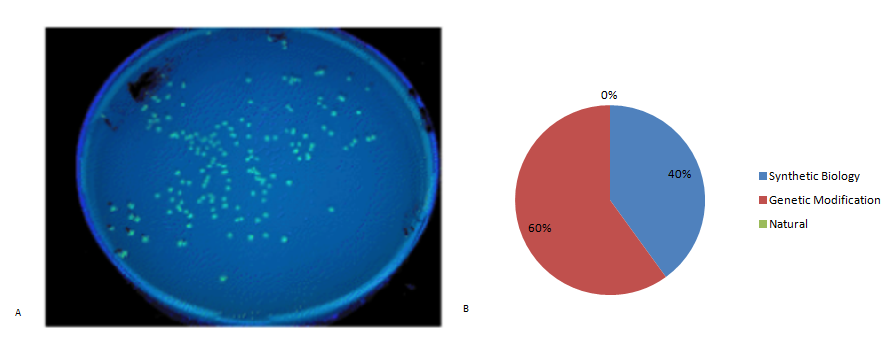|

Figure 5.A. shows an image of purple tomatoes, which scientists have developed which may boost health due to their anti-cancer properties. Image B shows how 92% of people understood the purple tomatoes to be genetically modified, whereas 8% thought it was synthetic biology.
|
Interviews
For our human practice we wanted to explore our central question; is synthetic biology feared by approaching the issue in a number of different ways.
Once the topic of synthetic biology had been introduced we wanted to know what people’s thoughts and feelings were on the matter and why they had these opinions. We conducted a number of interviews with the general public and planned synthetic biology based outreach events (please see our outreach section) in order to gain both adults and children’s perspective. The interviews allowed us the chance to analyse responses and explore whether synthetic biology is in fact a feared topic.
Not only did we want to get people’s opinions on synthetic biology we also wanted to demonstrate that it is different from genetic modification and to see how many people knew of the difference between the two terms. This was achieved by offering definitions of each term during the interview and by showing a series of images which the interviewee could say they thought represented synthetic biology, genetic modification or nature. The responses from the interviews and the results for the image tests can be seen below.
-
Interview One
Interview Two
Interview Three
Interview Four
Interview Five
Interview Six
Interview Seven
Interview Eight
Interview Nine
Interview Ten
Interview Eleven
Interview Twelve
-
Quantitative Data:
In order to collect quantitative data, we showed participants the following images during each interview and asked them to determine whether they perceived the image as representing synthetic biology, genetic modification, nature or even combinations of all three.
Figure 1.A shows a Tricolour Beagle dog, which was selectively bred to give the modern breed. Image B shows that 86% of the people we interviewed perceived the Beagle to be natural. However, 14% concluded it may also be genetically modified in terms of selective breeding, although does not involve the introduction of genes from a different species.
Human Practice In Schools
In order to get the perspective of children and their views on synthetic biology we were able to ask the children questions during the SAW project when synthetic biology remained the theme for the whole of their schooling day. Every child was asked the same question...“After learning more about DNA and designing a synthetic organism of your own do you fear the topic of synthetic biology?”.
One of the limitations of our iGEM experience was that there was only a set amount of time in which to organise and run our outreach events hindered even more by the fact that iGEM takes place over the school’s summer holidays. Due to this we were unable to hold more outreach events during the children’s term time and we had only the data we were able to collect in this time to analyse shown by the graphs below.
Approaching the issue of Human Practice and planning and implementing outreach events gave the members of our iGEM team an opportunity for self reflection. Every member of the iGEM team has gained something from taking part and a couple of our iGEM team members wrote about their experiences which can be seen on our outreach page.